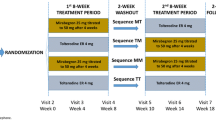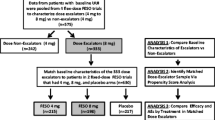Abstract
Introduction and hypothesis
To confirm the efficacy and tolerability of extended release (ER) trospium chloride in women with overactive bladder syndrome (OAB), data from two identical phase III studies were analyzed.
Methods
Adults (aged ≥ 18 years) who had OAB with urinary urgency, frequency, and urge urinary incontinence (UUI) were randomized to trospium ER 60 mg or placebo once daily for 12 weeks. The analysis included 989 women (trospium ER, n = 484; placebo, n = 505). Endpoints examined included changes from baseline in number of toilet voids and UUI episodes/day at week 12. Continuous data were analyzed using rank analysis of variance.
Results
At week 12, significantly greater mean reductions in numbers of toilet voids and UUI episodes/day occurred with trospium ER versus placebo (P < 0.0001). Adverse events considered at least possibly related to treatment with trospium ER included dry mouth (11.4%) and constipation (8.9%).
Conclusions
Trospium ER was effective and well tolerated in women with OAB.



Similar content being viewed by others
References
Stewart WF, Van Rooyen JB, Cundiff GW, Abrams P, Herzog AR, Corey R et al (2003) Prevalence and burden of overactive bladder in the United States. World J Urol 20:327–336
Dmochowski RR, Newman DK (2007) Impact of overactive bladder on women in the United States: results of a national survey. Curr Med Res Opin 23:65–76
Milsom I, Abrams P, Cardozo L, Roberts RG, Thuroff J, Wein AJ (2001) How widespread are the symptoms of an overactive bladder and how are they managed? A population-based prevalence study. BJU Int 87:760–766
Campbell UB, Stang P, Barron R (2007) Survey assessment of continuation of and satisfaction with pharmacological treatment for urinary incontinence. Value Health 11:726–732
Dmochowski RR, Sand PK, Zinner NR, Staskin DR (2008) Trospium 60 mg once daily (QD) for overactive bladder syndrome: results from a placebo-controlled interventional study. Urology 71:449–454
Staskin D, Sand P, Zinner N, Dmochowski R (2007) Once daily trospium chloride is effective and well tolerated for the treatment of overactive bladder: results from a multicenter phase III trial. J Urol 178:978–983
Nixon A, Colman S, Sabounjian L, Sandage B, Schwiderski UE, Staskin DR et al (2005) A validated patient reported measure of urinary urgency severity in overactive bladder for use in clinical trials. J Urol 174:604–607
Zinner N, Harnett M, Sabounjian L, Sandage B Jr, Dmochowski R, Staskin D (2005) The overactive bladder-symptom composite score: a composite symptom score of toilet voids, urgency severity and urge urinary incontinence in patients with overactive bladder. J Urol 173:1639–1643
Kelleher CJ, Cardozo LD, Khullar V, Salvatore S (1997) A new questionnaire to assess the quality of life of urinary incontinent women. Br J Obstet Gynaecol 104:1374–1379
Coyne K, Revicki D, Hunt T, Corey R, Stewart W, Bentkover J et al (2002) Psychometric validation of an overactive bladder symptom and health-related quality of life questionnaire: the OAB-q. Qual Life Res 11:563–574
Melville JL, Delaney K, Newton K, Katon W (2005) Incontinence severity and major depression in incontinent women. Obstet Gynecol 106:585–592
Wilson L, Brown JS, Shin GP, Luc KO, Subak LL (2001) Annual direct cost of urinary incontinence. Obstet Gynecol 98:398–406
Wein AJ, Khullar V, Wang JT, Guan Z (2007) Achieving continence with antimuscarinic therapy for overactive bladder: effects of baseline incontinence severity and bladder diary duration. BJU Int 99:360–363
Cardozo L, Castro-Diaz D, Gittelman M, Ridder A, Huang M (2006) Reductions in overactive bladder-related incontinence from pooled analysis of phase III trials evaluating treatment with solifenacin. Int Urogynecol J Pelvic Floor Dysfunct 17:512–519
Dmochowski RR, Sand PK, Zinner NR, Gittelman MC, Davila GW, Sanders SW (2003) Comparative efficacy and safety of transdermal oxybutynin and oral tolterodine versus placebo in previously treated patients with urge and mixed urinary incontinence. Urology 62:237–242
Kay G, Crook T, Rekeda L, Lima R, Ebinger U, Arguinzoniz M et al (2006) Differential effects of the antimuscarinic agents darifenacin and oxybutynin ER on memory in older subjects. Eur Urol 50:317–326
Staskin DR, Harnett MD (2004) Effect of trospium chloride on somnolence and sleepiness in patients with overactive bladder. Curr Urol Rep 5:423–426
Diefenbach K, Arold G, Wollny A, Schwantes U, Haselmann J, Roots I (2005) Effects on sleep of anticholinergics used for overactive bladder treatment in healthy volunteers aged ≥50 years. BJU Int 95:346–349
Todorova A, Vonderheid-Guth B, Dimpfel W (2001) Effects of tolterodine, trospium chloride, and oxybutynin on the central nervous system. J Clin Pharmacol 41:636–644
Kay G, Malhotra B, Michel MC (2009) Assessment of central nervous system access of a new antimuscarinic drug, fesoterodine. J Urol 181(Suppl.):84
Sandage B, Lerch G, Larsen G, Profy A (2009) Trospium chloride does not cross the blood-brain barrier of male Long Evans rats. Neurology 72(Suppl 3):A50
Geyer J, Gavrilova O, Petzinger E (2009) The role of P-glycoprotein in limiting brain penetration of the peripherally acting anticholinergic OAB drug trospium chloride. Drug Metab Dispos 37(7):1371–1374
Rudy D, Cline K, Harris R, Goldberg K, Dmochowski R (2006) Multicenter phase III trial studying trospium chloride in patients with overactive bladder. Urology 67:275–280
Zinner N, Gittelman M, Harris R, Susset J, Kanelos A, Auerbach S (2004) Trospium chloride improves overactive bladder symptoms: a multicenter phase III trial. J Urol 171:2311–2315 quiz 2435
Birns J, Lukkari E, Malone-Lee JG (2000) A randomized controlled trial comparing the efficacy of controlled-release oxybutynin tablets (10 mg once daily) with conventional oxybutynin tablets (5 mg twice daily) in patients whose symptoms were stabilized on 5 mg twice daily of oxybutynin. BJU Int 85:793–798
Van Kerrebroeck P, Kreder K, Jonas U, Zinner N, Wein A (2001) Tolterodine once-daily: superior efficacy and tolerability in the treatment of the overactive bladder. Urology 57:414–421
Dmochowski R, Abrams P, Marschall-Kehrel D, Wang JT, Guan Z (2007) Efficacy and tolerability of tolterodine extended release in male and female patients with overactive bladder. Eur Urol 51:1054–1064
Swift S, Garely A, Dimpfl T, Payne C (2003) A new once-daily formulation of tolterodine provides superior efficacy and is well tolerated in women with overactive bladder. Int Urogynecol J Pelvic Floor Dysfunct 14:50–54 discussion 54-55
van Leeuwen JH, Castro R, Busse M, Bemelmans BL (2006) The placebo effect in the pharmacologic treatment of patients with lower urinary tract symptoms. Eur Urol 50:440–452
Nabi G, Cody JD, Ellis G, Herbison P, Hay-Smith J (2006) Anticholinergic drugs versus placebo for overactive bladder syndrome in adults. Cochrane Database Syst Rev 4:CD003781
Acknowledgements
Editorial support for the development of this manuscript was provided by Catherine Rees and Sushma Soni. This support was funded by Allergan, Inc.
Funding
This work was supported by Allergan, Inc. and Endo Pharmaceuticals (formerly Indevus Pharmaceuticals Inc.).
Conflicts of interest
Peter K. Sand, MD, serves as an advisor and speaker for Allergan, Inc., Astellas Pharma US, Inc., Pfizer, Ortho-McNeil, Colplast, and Watson Pharmaceuticals. Dr. Sand has received grants from Allergan, Inc., Astellas Pharma US, Inc., Boston Scientific, Pfizer, Ortho-McNeil, Watson Pharmaceuticals, and Antares Pharma.
Roger R. Dmochowski, MD, has financial relationships with Allergan, Inc., Pfizer, Watson Pharmaceuticals, Novartis, and Astellas Pharma US, Inc.
David R. Staskin, MD, serves as a consultant and lecturer for Allergan, Inc., Pfizer, Watson Pharmaceuticals, and Astellas Pharma US, Inc.
Norman R. Zinner, MD, serves as a consultant, speaker, and/or for a clinical trial for Allergan, Inc., Actelion, Watson Pharmaceuticals, Pfizer, Novartis, Ferring Pharmaceuticals, and GlaxoSmithKline.
Rodney A. Appell, MD (deceased), was on the advisory board for Pfizer, Boston Scientific, and Astellas Pharma US, Inc. Dr. Appell held stock in American Medical Systems. Dr. Appell served as an investigator for Allergan, Inc., Astellas Pharma US, Inc., Watson Pharmaceuticals, American Medical Systems, Boston Scientific, Solace Technology, Bulkamid, and Novasys Medical.
Author information
Authors and Affiliations
Corresponding author
Additional information
Rodney A. Appell: deceased
Rights and permissions
About this article
Cite this article
Sand, P.K., Dmochowski, R.R., Zinner, N.R. et al. Trospium chloride extended release is effective and well tolerated in women with overactive bladder syndrome. Int Urogynecol J 20, 1431–1438 (2009). https://doi.org/10.1007/s00192-009-0969-8
Received:
Accepted:
Published:
Issue Date:
DOI: https://doi.org/10.1007/s00192-009-0969-8




